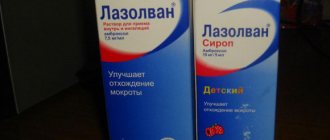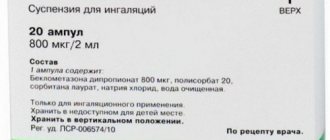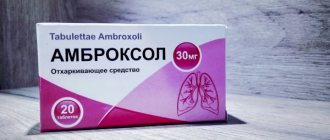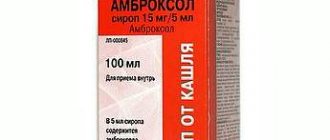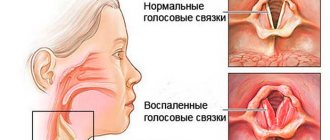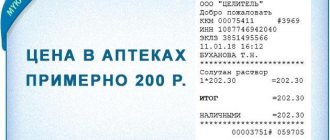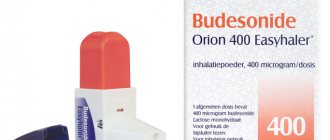Inhalation procedures are one of the most effective tools in the treatment of diseases of the respiratory system that are accompanied by severe coughing. Ambrohexal for inhalation therapy perfectly dilutes sputum, which ensures its rapid removal and cleansing of the lungs and bronchi. But when using inhalation to treat respiratory diseases, you need to know how to perform the procedure correctly and how much medicine to take to refill the nebulizer. This is what this article will be devoted to.
For what diseases is it used?
Ambrohexal is prescribed for the treatment of respiratory diseases, which are accompanied by a prolonged cough and poor sputum discharge. During the inhalation procedure, the active component of the drug acts directly on the affected area. Thanks to the high temperature of the steam, viruses and bacteria do not multiply. This means that two methods are used simultaneously to destroy them: chemical and thermal. Sputum is released in a shorter time, and the effect of the drug leads to the death of pathogenic microorganisms.
The solution has been successfully used:
- in the presence of acute diseases of the respiratory system that are chronic;
- for the treatment of acute bronchitis;
- with pneumonia;
- with bronchial asthma, which is accompanied by difficulty removing sputum;
- with cystic fibrosis;
- for pulmonary tuberculosis;
- with obstructive pulmonary disease;
- in the presence of bronchiectasis.
The duration of the course can be reduced by starting treatment immediately after the first symptoms of the disease appear.
Pharmacodynamics
Ambrohexal is an organic compound that has expectorant, secretolytic and secretomotor effects. Due to the depolymerization of mucopolysaccharides contained in sputum, associated with the rupture of disulfide bonds in molecules, the drug helps reduce the viscosity of sputum, normalizing the ratio of the serous and mucous components, increases the motor activity of the ciliated epithelium, increases mucolytic transport (removal of pathogenic agents) and facilitates the removal of sputum from the respiratory tract. By having a direct effect on Clark cells located in the bronchioles of the lungs and alveolar type II pneumocytes, Ambrohexal promotes the activation of surfactant (a surfactant that prevents the collapse of alveoli during exhalation).
The therapeutic effect occurs 30 minutes after taking the drug. The duration of action, depending on the dose taken, is 6-12 hours.
Contraindications
Inhalation therapy using Ambrohexal can be started only after familiarization with the contraindications of the medicinal solution. The drug is contraindicated in the following cases:
- For dry cough, including due to allergies.
- Patients should use the drug with caution if they have a weakened cough reflex, since in this case mucus accumulates.
- During the treatment period, you should not do breathing exercises.
- If you have bronchial asthma, your cough may worsen.
- It is not recommended to perform the inhalation procedure before going to bed.
- If kidney and liver function are impaired, use of the drug is recommended only under the supervision of a doctor, reducing the dose or increasing the interval between inhalations.
- Use Ambrohexal with extreme caution if you have poor tolerance to fructose; be sure to consult your doctor.
- Pregnant women who are in the first trimester should not take the drug.
- Ambrohexal should be used very carefully and under medical supervision by pregnant women in the second and third trimesters, as well as during the lactation period.
Ambrohexal solution for oral administration and inhalation 7.5 mg/ml 100 ml bottle No. 1
Trade name of the drug: AMBROGEXAL International nonproprietary name (INN): Ambroxol Dosage form: syrup.
Composition: 1 ml of syrup contains: Active substance: ambroxol hydrochloride 3 mg/ml Other ingredients: benzoic acid, sodium metabisulfite, citric acid monohydrate, sodium hydroxide, polyvidone, sorbitol solution 70%, glycerin 85%, sodium cyclamate, raspberry flavor, purified water.
Description Transparent or almost transparent, colorless or slightly yellowish liquid (similar to syrup), without foreign particles. Pharmacotherapeutic group: Medicines used for coughs and colds. Mucolytic agents. ATX code: [К.05СВ06]
Pharmacological properties Pharmacodynamics It has a secretomotor (improving sputum transport) and secretolytic effect (reducing the viscosity of sputum), facilitates expectoration; stimulates the serous cells of the glands of the bronchial mucosa, increases the content of mucous secretion and the release of surfactant in the alveoli and bronchi; normalizes the disturbed ratio of serous and mucous components of sputum. By activating hydrolyzing enzymes and enhancing the release of lysosomes from Clark cells, it reduces the viscosity of sputum. Increases the motor activity of the cilia of the ciliated epithelium, increases the mucociliary transport of sputum. After oral administration, the effect occurs within 30 minutes. and continues for 6-12 hours. Pharmacokinetics Absorption is high, time to reach maximum concentration is 1-3 hours after oral administration, binding to blood plasma proteins is 80-90%. The drug is metabolized in the liver to inactive metabolites (dibromanthranilic acid and glucuronic conjugates). The half-life from plasma (T1/2) is from 7 to 12 hours. The total plasma half-life of ambroxol and its metabolites is approximately 22 hours. 90% of ambroxol is excreted by the kidneys in the form of metabolites, 10% unchanged. Due to its high protein binding and large volume of distribution, as well as slow redistribution from tissues to blood, significant elimination of ambroxol by dialysis or forced diuresis is not expected. Ambroxol clearance decreases by 20 - 40% in severe hepatopathy. In cases of severe renal dysfunction, the half-life of ambroxol metabolites increases. Ambroxol penetrates the blood-brain barrier, the placental barrier, and is excreted in breast milk.
Indications for use Acute and chronic diseases of the respiratory tract with the release of viscous sputum: acute and chronic bronchitis, chronic obstructive pulmonary disease, pneumonia, bronchial asthma with difficulty in sputum discharge, bronchiectasis.
Contraindications Hypersensitivity to ambroxol or other components of the drug; children under 2 years of age.
Directions for use and dosage Adults: 2-3 days, 3 times a day, 2 scoops (equivalent to 90 mg of ambroxol hydrochloride per day), and then 2 times a day, 2 scoops (equivalent to 60 mg of ambroxol hydrochloride per day). In severe cases of the disease, the dose is not reduced throughout the entire course of treatment. The maximum dose is 2 times a day, 4 scoops (equivalent to 120 mg of ambroxol hydrochloride per day). Children aged 6 to 12 years: prescribed 2-3 times a day, 1 measuring spoon (equivalent to 30-45 mg of ambroxol hydrochloride per day). Children aged 2 to 5 years: prescribed 3 times a day, 1A measuring spoon (equivalent to 22.5 mg of ambroxol hydrochloride per day). During treatment, it is necessary to drink plenty of fluids (juices, tea, water) to enhance the mucolytic effect of the drug. The duration of therapy depends on the severity of the disease and is determined by the attending physician. Without a doctor's recommendation, you should not take AmbroHEXAL for more than 4-5 days.
Side effects Like all medicines, Ambrohexal can cause side effects, although not everyone gets them. The assessment of side effects is based on the frequency of their occurrence: very common: more than 1 in 10 patients common: 1 - 10 patients in 100 uncommon: 1 - 10 patients in 1,000 rare: 1 - 10 patients in 10,000 very rare : less than 1 in 10,000 patients not established: based on available data, cannot be established. Disorders of the immune system, skin and subcutaneous tissues Uncommon: hypersensitivity reactions (rash, urticaria and other reactions of the skin and mucous membranes, angioedema, shortness of breath, itching), fever Very rare: anaphylactic reactions, including anaphylactic shock Disorders of the nervous system systems Common: taste disturbance (change in taste) Digestive system disorders Common: nausea, diarrhea Uncommon: vomiting, dyspepsia and abdominal pain Rare: heartburn Very rare: constipation, hypersalivation Respiratory, chest and mediastinal disorders Common: numbness of the mouth and pharynx Uncommon: dry mouth Very rare: rhinorrhea, dry airways Frequency unknown: dry throat Renal and urinary tract disorders Very rare: dysuria If you notice any adverse reactions, including those not mentioned in this leaflet , please tell your doctor about this.
Special instructions and precautions for use There have been very rare reports of severe skin lesions, such as Stevens-Johnson syndrome and toxic epidermal necrolysis, which were associated in time with the use of expectorants such as ambroxol hydrochloride. In most cases, such reactions were associated with the severity of the patient's underlying disease and/or concomitant therapy. Additionally, in the early stages of Stevens-Johnson syndrome or toxic epidermal necrolysis, patients may initially experience flu-like symptoms, such as fever, body aches, runny nose, cough and sore throat. It is possible that due to confusion by these nonspecific flu-like symptoms, symptomatic treatment was started with cold and cough medications. In this regard, if signs of a reaction appear on the skin or mucous membrane, you should immediately consult a doctor and, as a precaution, stop treatment with ambroxol hydrochloride. If you have impaired renal function or severe hepatopathy, you should take ambroxol only after consulting your doctor. As with any drug with hepatic metabolism followed by renal excretion, accumulation of ambroxol metabolites should be expected in severe renal failure. In patients with impaired bronchial motility and copious bronchial secretions (as, for example, in the rare syndrome of primary ciliary dyskinesia), Ambrohexal should be used with caution due to the risk of difficulty with the discharge of large amounts of sputum and blockage of the bronchi. Patients with rare congenital fructose intolerance should not take this medicine.
Instructions for diabetics: 1 measuring spoon (5 ml of syrup) contains 1.75 g of sorbitol (less than 0.15 XE).
Interaction with other drugs The use of ambroxol hydrochloride with antitussive drugs leads to complications in sputum discharge while reducing cough, so this combination should not be used. The use of ambroxol hydrochloride with antibiotics (amoxicillin, cefuroxime, erythromycin and doxycycline) increases the concentration of antibiotics in sputum and bronchial secretions.
Use during pregnancy and breastfeeding The drug is not recommended for use during the first trimester of pregnancy. If it is necessary to use ambroxol in the II-III trimesters of pregnancy, the potential benefit for the mother should be assessed with the possible risk to the fetus. Ambroxol hydrochloride is excreted into breast milk, and therefore its use is not recommended during breastfeeding.
Overdose Overdose caused by ambroxol is not accompanied by serious toxic effects. Symptoms: possible transient anxiety, diarrhea. With a significant overdose, hypersalivation, vomiting, and arterial hypotension are possible. Treatment: emergency measures such as inducing vomiting and gastric lavage are not indicated; they are used only in case of significant overdose in the first 1-2 hours. If necessary, symptomatic therapy is recommended.
Effect on the ability to drive a car and operate machinery There are no prerequisites for the drug to influence the ability to drive vehicles or operate machinery. No studies have been conducted on this effect.
Release form Syrup 3 mg/ml. 100 ml in dark glass bottles. A bottle with a measuring spoon in a cardboard box with instructions for use.
Storage conditions: Protected from light at a temperature not exceeding 25C. Keep out of the reach of children!
Shelf life: 3 years. Store an opened bottle for no more than 1 year! Do not use the drug after the expiration date.
Dispensed from pharmacies Without a prescription. Manufacturer
List of side effects
As a result of inhalations with ambrohexal and saline, the patient may experience adverse reactions. The most common side effects from using the drug include:
- Attacks of nausea;
- Taste sensations change;
- The sensitivity of tissues in the oral cavity and pharynx decreases;
Not so often, but you can see:
- Allergic manifestations;
- Disturbances in the digestive system;
- The appearance of dryness on the mucous membranes.
Pharmacokinetics
After inhalation with Ambrohexal, the degree of absorption of the drug is 25-30% of the administered dose. Maximum concentration in the lungs. Disintegrates to form metabolites excreted by the kidneys (glucuronides, dibromanthranilic acid).
Plasma protein binding – 80-90%. 90% of the drug is excreted in the form of metabolites by the kidneys, 10% is excreted unchanged. Due to the high binding to plasma proteins, the large initial volume of distribution and slow redistribution from tissues to the blood, the drug is not released during hemodialysis and forced diuresis.
In severe liver pathologies, the clearance of Ambrohexal is reduced by 20-40%. In severe renal impairment, T1/2 of drug metabolites increases.
Ambrohexal is able to penetrate the cerebrospinal fluid, pass through the placenta and enter breast milk.
Instructions for use
Before starting inhalation therapy, you need to make sure that the cough is not a consequence of an allergic reaction. Ambrohexal is prescribed only if the disease is of viral origin. If the cough is a consequence of an allergy, then treatment with Ambrohexal is not effective.
How to dilute - dosage
According to the instructions for use attached to the drug, Ambrohexal must be diluted with physiological solution, observing the following proportions:
- For a child under 2 years of age - dilute 20 drops of the drug (1 ml) in 40 drops of saline;
- For a child aged 2 to 6 years – dilute 40 drops of the drug (2 ml) in 80 drops of saline solution;
- For a child over 6 years of age and older, dilute 60 drops of Ambrohexal (3 ml) in 80 drops of saline solution.
In the instructions for the inhaler, you can sometimes read information that when carrying out the procedure in the nebulizer, the amount of liquid should be at least 8 milliliters. Otherwise, the quality of inhalation therapy decreases. To get 8 milliliters of solution, you should dilute 60 drops of the drug in 100 drops of saline solution.
Attention! The dosage of Ambrohexal for inhalation procedures should only be calculated by the attending physician. It is unacceptable to self-medicate to avoid negative consequences.
How to do inhalations in a nebulizer
It is necessary to carry out inhalation therapy using a nebulizer, adhering to the following rules:
- Before starting the procedure, you need to prepare a healing solution. It is necessary to pour the medicine mixed with saline solution in the appropriate proportion into the inhaler container.
- The inhalation procedure is allowed only an hour after eating.
- When inhaling the drug, breathing should be even and deep.
- During the procedure you cannot talk, read books or watch TV.
- To avoid coughing attacks during therapy, it is not allowed to take medications with mucolytic effects before inhalation.
- It is not recommended to leave the house for an hour after the end of inhalation.
Attention! Before inhalation, it is recommended to bring the prepared solution to body temperature, warming it up slightly.
Release form
- Round and flat tablets (white, with rounded edges) with a score line on one side. Packages of 20, 30, 50 and 100 pieces.
- White gelatin capsules with white or pinkish powder inside. Packages of 10, 20, 50 or 100 pieces.
- Transparent, slightly yellowish viscous syrup. Available in 100 or 250 ml bottles, including a measuring spoon.
- Ambrohexal solution for inhalation and oral administration is transparent, colorless. In bottles with a dispenser and a measuring cup of 50 and 100 mg.
Duration of treatment and its features
The duration of inhalation therapy with Ambrohexal can be determined exclusively by the attending physician. The course of treatment lasts no more than 5 days. If the patient’s condition worsens or after this time no improvement is visible, you should seek medical advice.
For children
One of the main advantages of Ambrohexal is the ability to treat cough in babies, starting from birth. According to the instructions for use, Ambrohexal for inhalation is used no more than 1-2 times a day. The duration of one session cannot exceed 3 minutes.
Adult patients
It is recommended for an adult to do inhalation therapy 1-2 times a day. The duration of one procedure is no more than 5 minutes.
Attention! How long the course of treatment should last should be determined only by the attending physician.
Interaction with other drugs
When using Ambrohexal injection solution simultaneously with antitussives that inhibit the cough reflex, stagnation of sputum may occur, leading to the development of quite dangerous conditions. Therefore, such combinations must be selected with extreme caution.
With the combined use of Ambrohexal and antibacterial drugs (amoxicillin, erythromycin, cefuroxime and doxycycline), there is a significant increase in the concentration of etiotropic components in the bronchial secretions.
Reviews and prices in pharmacies
Patients who have tried Ambrohexal for inhalation therapy respond positively to the drug. It is successfully used in the treatment of diseases of the respiratory system in children. Ambrohexal is an effective mucolytic agent that helps cure dry cough within a week. The drug practically does not cause adverse reactions, in addition to hypersensitivity in the patient to some of its components.
Ambrohexal attracts patients due to its cost. The price of one bottle with a capacity of 50 ml does not exceed 110 rubles.
Ambrohexal's analogs
The most popular analogues of Ambrohexal include:
- Lazolvan - the solution is used for inhalation, having previously diluted it with saline solution (0.9%) in a 1:1 ratio, cost - 170-200 rubles;
- Ambrobene - available in the form of tablets and syrup, a solution for inhalation, which is diluted with saline in a 1:1 ratio, price - 120 rubles.
If we consider analogs with the main active ingredient ambroxol hydrochloride, then there are many of them - Abrol, Ambrosan, Amkesol, Dignobroxol and others. But they are available in the form of syrups and tablets and cannot be used for inhalation.
We recommend reading the article on how to use Ambrobene for inhalation. From the article you will learn about the main characteristics and rules for using Ambrobene for inhalation, as well as about analogues of this drug. And here is more information about how to use Lazolvan for inhalation and for whom.
Ambrohexal is a powerful mucolytic that ensures rapid formation and high-quality discharge of sputum from the lungs and bronchi. It is rarely used in pediatric practice, but is often used to treat various respiratory diseases in adults, regardless of their etiology.
Summarizing
Inhalations using ambrohexal are a reliable tool for treating infectious coughs accompanied by difficulties with sputum removal. The medicine is practically safe, which allows it to be taken by children and adults with serious concomitant illnesses. Ambrohexal for oral administration and inhalation can be used for children from infancy and people suffering from diabetes.
Previous
Preparations for inhalation Solutions for inhalation with a nebulizer for children and adults
Next
Preparations for inhalationPulmicort and Berodual for inhalation for children and adults
Compound
One Ambrohexal tablet contains ambroxol hydrochloride (active ingredient) - 0.03 g + excipients ( calcium hydrogen phosphate, corn starch, magnesium stearate, lactose monohydrate, sodium carboxymethyl starch, colloidal silicon dioxide ).
Capsules (extended release) contain active ingredient - 0.075 g + excipients ( eudragide RL30D, triethyl citrate, titanium dioxide, eudrahydride RS30D, red iron oxide, MCC, magnesium stearate ).
Ambrohexal syrup. For 5 ml of syrup, the active substance is 0.015 mg + excipients ( benzoic acid, raspberry essence, citric acid monohydrate, sorbitol solution, polyvidone, sodium cyclamate, sodium metabesulfite, water, sodium hydroxide, glycerol ).
A solution for inhalation and oral administration (one milliliter) contains the active substance - 7.5 mg + excipients ( citric acid, methyl parahydroxybenzoate, sodium disulfite, sodium hydroxide, purified water ).


